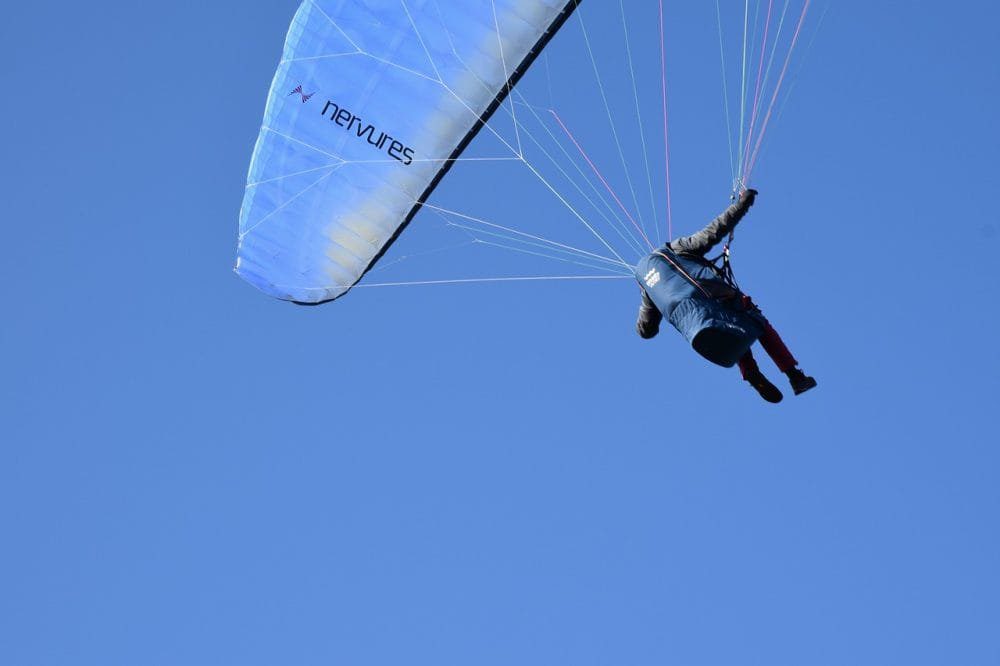
Most paraglider pilots eagerly await the spring. The long, cold winter months deter most pilots from flying, instead they wait for the milder temperatures and the exhilarating thermals that come with flying during this turbulent season.
However, spring is also the paragliding season in which most accidents happen, as a combination of the challenging flying conditions and the lack of practice carried out by gliders over the winter.
Because of the nature of the sport, paragliding mistakes are often serious.
With this in mind, we’ve compiled a few tips to help you return to paragliding safely and enjoy your best flying season yet.
Get in shape.
Most of us are pretty inactive over the winter – with the cold stopping us from spending as much time out and about, and the holidays encouraging us to relax and indulge – meaning that, come spring, we’re not as strong or as fit as we once were.
This is bad news for our paragliding skills, as the sport requires exceptional balance and strength in order to take off and land safely. Flying can also drain energy, so being in shape is required.
What’s more: spring is known for its often challenging weather conditions, as there are typically stronger thermals in this season than any other, making it extra tough on the body.
So, try to improve your strength and balance before hitting up your favourite flying sites by undergoing strength training of your arms, legs, core and retraining your balance – yoga can be useful here.
Get your reserve repacked.
The official advice encourages paragliders to have their reserve repacked twice a year.
It’s a great idea to have your reserve repacked before you enter the spring paragliding season if you haven’t for a while, as it’s likely your reserve has been in your pack undisturbed for a long time. Deep creases may have formed during this time and may prevent your reserve from deploying effectively.
Plus, the moisture and any dirt from the previous paragliding season may still be present, which you’ll want to remove to ensure the continued function of your reserve.
Have your gear checked.
Just before the spring flying season is the optimal time to get your glider professionally checked, to ensure it’s ready to carry you through the rest of the year.
Over winter, as your kit is left unused in your loft or garage, moisture can shrink your lines; the fabric of your paraglider could be damaged or may be wearing out due to age.
Moreover, if you’ve had your carabiner for more than 5 years, it might be time to get new ones, since the consequence of a broken carabiner mid-flight could be fatal.
These are all things that a professional can check for to make sure that your gear is in the best condition it can be to keep you safe during your flight.
Upgrade your variometer.
Variometers are an essential accessory for flying efficiently, allowing pilots to locate thermals and achieve stability in the core (essential in spring flying conditions) among a number of other functionalities – and there are a number of types to choose from.
Refresh your knowledge.
Since you’ve had a break, there’s a good chance that your paragliding knowledge isn’t up to scratch – and it’s better to refresh your knowledge on the ground than to try and remember in the air at a critical moment.
With this in mind, it’s a good idea to read through the basics from your student notes to allow you to feel more comfortable and make better decisions up in the air. Reading articles online, especially on paragliding safety and flying anecdotes is also a good idea.
If you’ve taken a long break – and with both the winter and the events of the last 2 years, it’s likely you haven’t had much practice for a while – you might consider taking a refresher lesson, especially to get used to the more challenging weather conditions of spring.
Start out on the ground.
After a long period without flying, you’re probably keen to pick up right where you left off.
However, your physical – and mental – flying instincts are probably a little rusty, so it’s a good idea to practice on the ground first, focusing on inflating your glider, keeping it steady overhead and lowering it correctly. Spending a day or 2 on your local training hill is a good idea.
Moreover, when you come to take your first spring flight at your chosen flying site, it’s not a bad idea to sit and watch others first, to remind yourself of the physicality of the process, and to complete some ground handling in the weather conditions in which you’re about to fly.
Opt for mellow conditions and an easy flight to start.
It’s always tempting to try to pick up where you left off – but you’ve likely had a break over the winter and the spring paragliding conditions are some of the most physically and mentally challenging of the whole year.
So, make sure your first flight or two are at an easy site – ideally one you’ve flown before and know well – on a day with mild weather. If you get to the site and it seems like it might be a little rough, consider waiting until later in the day when the flying conditions are a little mellower.






